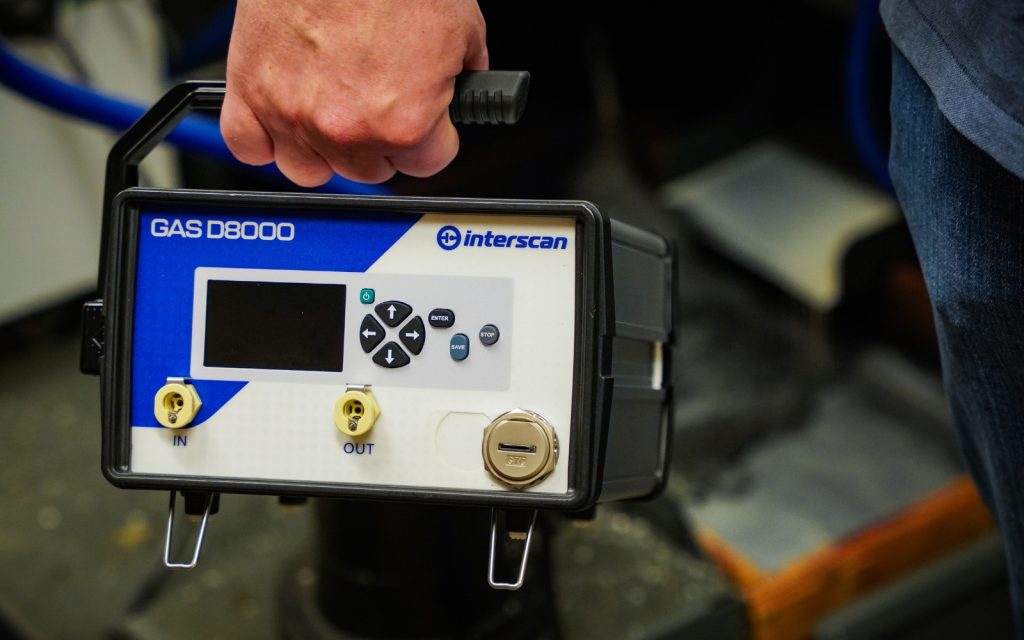- Fixed and portable gas detectors have different functions in industries.
- Fixed gas analyzers protect the facility and personnel by detecting accidental leaks and monitoring gas levels daily for compliance and process optimization.
- Portable gas analyzers protect individuals from exposure to hazardous gases in high-risk areas and jobs.
- The two systems’ use is not mutually exclusive.
Industrial hygienists and safety managers monitor hazardous gas concentrations to keep facilities safe for personnel. Portable and fixed gas detectors are the two types that are available and are used for different purposes. It is necessary to understand the functions, typical properties, and differences to decide which type of detector to use and where.
Fixed Gas Detectors

Fixed gas detectors or stationary gas detectors are installed permanently on walls. The fixed gas analyzers are meant to monitor gas levels and detect leaks to provide early alerts to initiate timely evacuation and safety measures to protect personnel and the facility.
Fixed gas detectors monitor the air continuously round-the-clock without staff involvement. Fixed monitors may need wiring and power systems for operation. Several gas sensors are nowadays wireless and connected to a control panel through the internet or intranet that identifies gas concentrations that have increased beyond safe prescribed limits. The control panel will start audio and visual alarms to warn workers if permissible gas limits (PEL) are exceeded. If one sensor detects high concentrations, the other sensors connected to the control panel will also sound the alarm, alerting all workers in the facility.
Fixed gas detectors are also linked to control safety systems, such as automatic opening or closing valves or shutting down processes.
Safety managers can monitor all work zones through the control panel simultaneously. The control is typically situated in safe locations to prevent endangering personnel from hazards. The data logging possibilities of a fixed gas system or associated software can provide records of the working conditions for compliance and process control.
Disadvantages
The fixed system’s disadvantage is that it can only detect gases, which diffuse into the sensors. The fixed monitors can miss localized leaks in zones not covered by sensors. Industry experience shows that fixed sensors are less likely to be bump tested and calibrated, reducing their reliability.
Portable Gas Detectors

Portable gas detectors are meant to protect individuals against potential exposure to hazardous gases for personnel who are first responders, utility crews, maintenance professionals, or entering confined spaces.
The portable gas detectors are light and small and are carried or worn on clothing by personnel not more than 10 inches away from their nose and mouth to cover breathing areas. Gases can sink or rise depending on their weight, so the aim is to estimate the air in the breathing zone using portable gas sensors. The portable gas monitors will activate audio and visual alarms if the gas levels exceed permissible levels for the target gases.
Since the area monitored by portable gas detectors is small and the devices are usually battery-powered, they are not meant for continuous area monitoring. Portable instruments are better maintained and tested than fixed gas detectors, making their readings more reliable. In several factories, the instruments are bump-tested automatically when replaced on the docking station.
Disadvantages
Portable gas sensors have some disadvantages compared to fixed systems. They are not connected to any safety or control systems, and mitigation decisions have to be made by the staff to avoid disasters. Moreover, the personnel must be able to use the devices. Therefore, the crew must be adequately trained in portable device use, safety protocols, and emergency procedures.
Considering the similarities and differences between the two gas detection systems can further inform managers when choosing the type and number of instruments to use.
Common Features
Fixed and portable gas detectors share several common properties and are used to keep workplaces safe that safety managers can count on. These are as follows:
- Point detectors: Fixed and portable gas analyzers are point detectors and can only detect those gases in contact with sensors.
- Single-gas or multiple-gas monitors: Both gas monitors aim to estimate the levels of target gas or gases in an industry that can be hazardous for people and the facility. Sensors in both fixed and portable gas analyzers can be single-gas or multiple-gas monitors that measure only one or several gases, respectively.
- Gas detection principle: Both fixed and portable gas will use the same gas detection principle to estimate gases. For example, electrochemical sensors detect gases like hydrogen sulfide or chlorine.
- Warning alerts: Both systems have audio and visual alarms activated when the target gas exceeds the PEL, when oxygen levels fall, or when there is a lower explosive limit (LEL) for gases that spontaneously combust.
- Maintenance: Fixed and portable gas analyzers need bump testings, ideally before every shift. Bump testing verifies the detector is functioning correctly and can detect the target gas/ gases. If the device results are not precise, they must be calibrated to ensure reading accuracy.
- Replacement: Both instruments will degrade over time and with use and must be replaced as manufacturers advise.
The differences between the two systems are crucial in determining choice and use.
Differences Between Fixed and Portable Gas Sytems
Table 1: Differences between Fixed and Portable Gas Detectors.
| Fixed Gas Detectors | Portable Gas Detectors | |
| 1 | The devices are for facility protection, detection of leaks, and compliance. | Primarily to protect personnel’s life and health. |
| 2 | Located and installed permanently in one location. | Carried by personnel where necessary in the facility or field. |
| 3 | Devices are large and can include a network of sensors. | Instruments are small and for individual use, with no connection to a network. |
| 4 | Used for continuous monitoring in permanent workstations. | Not made for continuous monitoring. Used for specific tasks like checks and maintenance, entry into confined spaces, or by first responders. |
| 5 | Monitor a limited space, but it is more significant than the breathing zone. Could miss leaks due to inadequate coverage. | Gas estimation is limited to the breathing zone of the user but has fewer misses of risks. |
| 6 | Needs wiring and a power supply. | A battery powers devices. |
| 7 | Connected to safety systems for risk management. | Not connected to any safety systems. |
| 8 | No personnel training and expertise are needed for operation. | The crew needs proper training in using portable devices. |
| 9 | They tend to be tested and calibrated less frequently, affecting their efficiency. | Personnel is more likely to bump test and calibrate devices regularly. |
The fixed and portable systems are meant to perform different functions, even if the common aim is gas concentration estimations.
Some of the essential differences are as follows:
- Function: Portable gas detectors are typically used to protect personnel’s lives and health, while fixed systems are meant to safeguard the facility and ensure compliance.
- Flexibility: The fixed systems are installed permanently in one spot and can only measure gases that diffuse to the sensors, while staff can move portable devices anywhere necessary.
- Size and connections: The fixed gas detectors are large, and several sensors can be part of a network connected to a central control panel operated remotely away from high-risk work zones.
- Personnel involvement: The fixed systems continuously monitor the air without staff, but the user operates portable gas detection for maintenance, emergency response, and confined space work.
- Coverage: If an adequate number of sensors are used, fixed systems can cover several work zones, but there is a risk of missing leaks in uncovered areas. The portable sensor measures air only close to the user’s breathing area, but being mobile makes it less likely to miss leaks.
- Power source: Fixed systems need wiring and a power supply, but portable devices are battery-powered.
- Safety measures: Fixed systems’ control panels are connected to safety systems to contain damage, but portable gas analyzer users must decide on their actions.
- Training necessity: No personnel training or expertise is needed for day-to-day operations for fixed gas detectors. However, personnel must be trained in using and maintaining portable devices.
- Maintenance: Fixed devices are bump-tested and calibrated less often than portable gas analyzers, making the latter’s accuracy more reliable.
Table 1 briefly summarizes the differences to help managers understand each gas detection system’s functions, advantages, and disadvantages.
Though fixed gas systems are primarily meant for facility monitoring, they protect staff lives by providing early warning for evacuation and preempting the need to involve people in daily tracking of gases in high-risk areas. However, the typical neglect of their maintenance makes portable sensors more reliable to avert disasters. So, the use of the two systems is not mutually exclusive. Depending on the industry and processes, portable and fixed devices can be necessary in any facility.
Choosing Reliable Gas Analyzing Systems
Industrial hygienists and safety managers can depend on Interscan for gas monitoring systems: AccuSafe Fixed Point Gas Detection and GASD 8000 Portable Gas Detector. The company provides gas sensors for around 20 hazardous gases and is suitable for use by various industries to keep facilities safe and protect personnel from harm.
Find out more about the two gas detection systems and services Interscan provides.
Written by:
 Vijayalaxmi Kinhal
Vijayalaxmi Kinhal
Science Writer, Interscan
Ph.D. Ecology and Environmental Science, B.Sc Agriculture
Source
Hall, J. E., Hooker, P., & Jeffrey, K. E. (2021). Gas detection of hydrogen/natural gas blends in the gas industry. International Journal of Hydrogen Energy, 46(23), 12555-12565. https://doi.org/10.1016/j.ijhydene.2020.08.200
